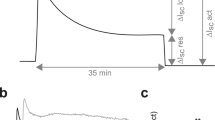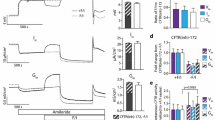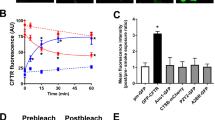Abstract
Cystic fibrosis (CF) is a genetic disease characterized by marked reduction in Cl− conductance across many epithelia. Two kinds of Cl− channels have been associated with CF. One channel, termed the cystic fibrosis transmembrane conductance regulator (CFTR), is directly coded by the CF gene1–3. The other channel is an outwardly rectifying depolarization induced Cl− channel (ORDIC) that is distinguished from other outwardly rectifying chloride channels (ORCCs) because its activity is induced most reliably by patch excision and depolarization4–7. An issue in current CF research is whether ORDIC channels are indirectly activated by CFTR to contribute a significant portion of apical membrane Cl− conductance in airway cells6. We now show that ORDIC channels are readily activated in patches excised and depolarized from isolated cells, but are rarer or refractory to activation in patches from the apical membranes of confluent human airway epithelia. These findings have important implications for proposed therapies that would bypass the CFTR conductance by activating ORDIC channels.
This is a preview of subscription content, access via your institution
Access options
Subscribe to this journal
Receive 12 print issues and online access
$209.00 per year
only $17.42 per issue
Buy this article
- Purchase on Springer Link
- Instant access to full article PDF
Prices may be subject to local taxes which are calculated during checkout
Similar content being viewed by others
References
Riordan, J.R. et al. Identification of the cystic fibrosis gene: Cloning and characterization of complementary DNA [erratum appears in Science 245, 1437; 1989]. Science 245, 1066–1073 (1989).
Anderson, M.P. et al. Demonstration that CFTR is a chloride channel by alteration of its anion selectivity. Science 253, 202–205 (1991).
Bear, C.E. et al. Purification and functional reconstitution of the cystic fibrosis transmembrane conductance regulator (CFTR). Cell 68, 809–818 (1992).
Welsh, M.J. An apical-membrane chloride channel in human tracheal epithelium. Science 232, 1648–1650 (1986).
Egan, M. et al. Defective regulation of outwardly rectifying Cl− channels by protein kinase A corrected by insertion of CFTR. Nature 358, 581–584 (1992).
Schwiebert, E.M. et al. CFTR regulates outwardly rectifying chloride channels through an autocrine mechanism involving ATP. Cell 81, 1063–1073 (1995).
Tabcharani, J.A. & Hanrahan, J.W. On the activation of outwardly rectifying anion channels in excised patches. Am. J. Physiol. 261, G992–G999 (1991).
Finkbeiner, W.E., Carrier, S.D. & Teresi, C.E. Reverse transcription-polymerase chain reaction (RT-PCR) phenotypic analysis of cell cultures of human tracheal epithelium, tracheobronchial glands, and lung carcinomas. Am. J. Respir. Cell Mol. Biol. 9, 547–556 (1993).
Shen, B.Q. et al. Calu-3: A human airway epithelial cell line that shows cAMP-dependent Cl− secretion. Am. J. Physiol. 266, L493–L501 (1994).
Haws, C., Finkbeiner, W.E., Widdicombe, J.H. & Wine, J.J. CFTR in Calu-3 human airway cells: Channel properties and role in cAMP-activated Cl− conductance. Am. J. Physiol. 266, L502–L512 (1994).
Cozens, A.L. et al. CFTR expression and chloride secretion in polarized immortal human bronchial epithelial cells. Am. J. Respir. Cell Mol. Biol. 10, 38–47 (1994).
Haws, C. et al. CFTR channels in immortalized human airway cells. Am. J. Physiol. 263, L692–L707 (1992).
Armitage, W.J., Juss, B.K. & Easty, D.L. Response of epithelial (MDCK) cell junctions to calcium removal and osmotic stress is influenced by temperature. Cryobiology 31, 453–460 (1994).
Gray, M.A. et al. Two types of chloride channel on duct cells cultured from human fetal pancreas. Am. J. Physiol. 257, C240–C251 (1989).
Volberg, T., Geiger, B., Kartenbeck, J. & Franke, W.W. Changes in membrane-microfilament interaction in intercellular adherens junctions upon removal of extracellular Ca2+ ions. J Cell Biol. 102, 1832–1842 (1986).
Shoemaker, R.L., Frizzell, R.A., Dwyer, T.M. & Farley, J.M. Single chloride channel currents from canine tracheal epithelial cells. Biochem. Biophys. Acta 858, 235–242 (1986).
Gabriel, S.E., Clarke, L.L., Boucher, R.C. & Stutts, M.J. CFTR and outward rectifying chloride channels are distinct proteins with a regulatory relationship. Nature 363, 263–268 (1993).
Schwiebert, E.M., Flotte, T., Cutting, G.R. & Guggino, W.B. Both CFTR and outwardly rectifying chloride channels contribute to cAMP-stimulated whole cell chloride currents. Am. J. Physiol. 266, C1464–C1477 (1994).
Bridges, R.J., Worrell, R.T., Frizzell, R.A. & Benos, D.J. Stilbene disulfonate blockade of colonic secretory Cl− channels in planar lipid bilayers. Am. J. Physiol. 256, C902–C912 (1989).
Shen, B.Q., Mrsny, R.J., Finkbeiner, W.E. & Widdicombe, J.H. Role of CFTR in chloride secretion across human tracheal epithelium. Am. J. Physiol. 269, L561–L566 (1995).
Brayden, D.J., Krouse, M.E., Law, T. & Wine, J.J. Stilbenes stimulate T84 Cl− secretion by elevating Ca2+. Am. J. Physiol. 264, G325G–333 (1993).
Bijman, J. et al. Characterization of human sweat duct chloride conductance by chloride channel blockers. Pfluegers Arch. 408, 511–514 (1987).
Grub, B.R., Paradise, A.M. & Boucher, R.C. Anomalies in ion transport in CF mouse tracheal epithelium. Am. J. Physiol. 267, C293–C300 (1994).
Knolls, M.R., Clarke, L.L. & Boucher, R.C. Activation by extracellular nucleotides of chloride secretion in the airway epithelia of patients with cystic fibrosis. N. Engl. J. Med. 325, 533–538 (1991).
Stutts, M.J. et al. Regulation of Cl− channels in normal and cystic fibrosis airway epithelial cells by extracellular ATP. Proc. Natl. Acad. Sci. USA 89, 1621–1625 (1992).
Stutts, M.J., Fitz, J.G., Paradiso, A.M. & Boucher, R.C. Multiple modes of regulation of airway epithelial chloride secretion by extracellular ATP. Am. J. Physiol. 267, C1442–C1451 (1994).
Anderson, M.P. & Welsh, M.J. Calcium and cAMP activate different chloride channels in the apical membrane of normal and cystic fibrosis epithelia. Proc. Natl. Acad. Sci. USA 88, 6003–6007 (1991).
Morris, A.P., Cunningham, S.A., Benos, D.J. & Frizzell, R.A. Cellular differentiation is required for cAMP but not Ca2+-dependent Cl− secretion in colonic epithelial cells expressing high levels of cystic fibrosis transmembrane conductance regulator. J. Biol. Chem. 267, 5575–5583 (1992).
Anderson, M.P., Sheppard, D.N., Berger, H.A. & Welsh, M.J. Chloride channels in the apical membrane of normal and cystic fibrosis airway and intestinal epithelia. Am. J. Physiol. 263, L1–L14 (1992).
Pisam, M. & Ripoche, P. Redistribution of surface macromolecules in dissociated epithelial cells. J. Cell Biol. 71, 907–920 (1976).
Graham, A., Steel, D.M., Alton, E.W. & Geddes, D.M. Second-messenger regulation of sodium transport in mammalian airway epithelia. J. Physiol. (Lond.) 453, 475–491 (1992).
Cammack, J.N. & Schwartz, E.A. Channel behavior in a gamma-aminobutyrate transporter. Proc. Natl. Acad. Sci. USA 93, 723–727 (1996).
Author information
Authors and Affiliations
Rights and permissions
About this article
Cite this article
Xia, Y., Haws, C. & Wine, J. Disruption of monolayer integrity enables activation of a cystic fibrosis “bypass” channel in human airway epithelia. Nat Med 3, 802–805 (1997). https://doi.org/10.1038/nm0797-802
Issue Date:
DOI: https://doi.org/10.1038/nm0797-802



